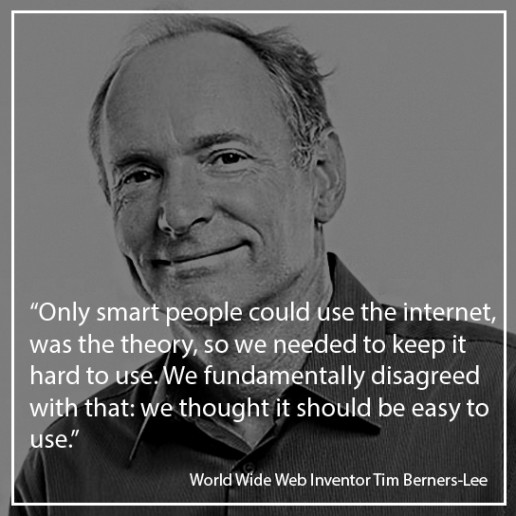To many people, the name Tim Berners-Lee may be an unfamiliar one. It certainly doesn’t carry the same recognition value among the general public as a Steve Jobs or a Mark Zuckerberg. But perhaps that should change—after all, if it wasn’t for Berners-Lee, you wouldn’t be able to read this biography about him on the Internet right now.
Berners-Lee is a significant figure in the field of computer science thanks to his invention of the World Wide Web in 1989. However, this claim should be taken with a sizable grain of salt. It would be a stretch to say that Berners-Lee “invented” the Internet, as many of the basic mechanisms had existed for years. What Berners-Lee did was marry technologies like hypertext and information transfer in order to create the Internet we know today.

Born in London on June 8, 1955, Timothy John Berners-Lee was one of four children belonging to Mary Lee Woods, a mathematician and computer programmer, and Conway Berners-Lee, a mathematician and computer scientist. As one might expect, young Timothy was himself interested in electronics as a child. After matriculating through the British school system, Berners-Lee attended The Queen’s College, Oxford, where he earned a bachelor’s degree in physics.
In 1980, Berners-Lee was working as an independent contractor for the European research organization CERN when he proposed a project based on the concept of hypertext. Berners-Lee developed a prototype named ENQUIRE that would enable researchers posted in different locations to share and update information.
In 1990, Berners-Lee teamed up with Belgian engineer Robert Cailliau to produce the first web browser and web server for the World Wide Web. The original aim of the World Wide Web was to publish hypertext web pages that anyone could access. Many of the elements we commonly associate with the Internet today, such as URLs, HTML and HTTP, were put into place by Berners-Lee and Cailliau during this period.
A few years later, in 1994, Berners-Lee founded the World Wide Web Consortium (W3C), an organization he still runs to this day. The role of the W3C is to oversee Web standards and promote its development. This development was accelerated thanks in large part to Berners-Lee’s decision not to seek a patent for his creation. Because the Internet is free and open source, innovators were able to create and thereby expand the possibilities of what was and is possible.
Berners-Lee believes in democratizing the Internet so that anyone can use it. Of course, we take this idea for granted today, but this wasn’t necessarily so in the early days of the Internet. As Berners-Lee once remarked to The Guardian, “Back then the key technical people didn’t want the internet to become easy to use….Only smart people could use the internet, was the theory, so we needed to keep it hard to use. We fundamentally disagreed with that: we thought it should be easy to use.”
In 2004, Berners-Lee was knighted by Queen Elizabeth in acknowledgement of “services to the global development of the internet.” In addition to his continued leadership of W3C, Berners-Lee holds prestigious positions with the MIT Computer Science and Artificial Intelligence Laboratory (CSAIL) the MIT Center for Collective Intelligence, and the Web Science Research Initiative (WSRI).
Tim Berners-Lee - Wikipedia
Sir Timothy John Berners-Lee (born 8 June 1955), also known as TimBL, is an English computer scientist, best known as the inventor of the World Wide Web. He made a proposal for an information management system in March 1989, and he implemented the first successful communication between a Hypertext Transfer Protocol (HTTP) client and server via the Internet in mid-November the same year.
Despite his accomplishments, Berners-Lee lives a relatively modest lifestyle. Once asked about his creation of the World Wide Web, he simply said he was “in the right place at the right time.” Whether it’s false modesty or not, thank goodness Berners-Lee was in “the right place” to lead the way for a free Internet.